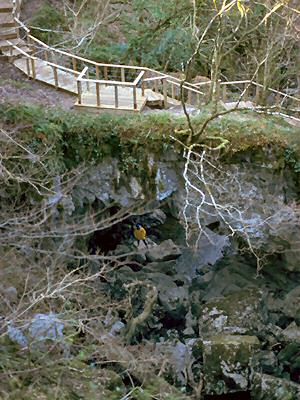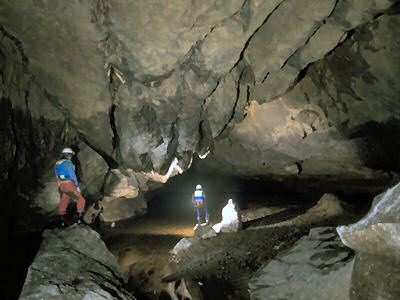Earth Science Conservation Review
| Marble Arch Karst; Marble Arch Cave | Fermanagh |
| Site Type: | Cave |
| Site Status: | ASSI |
| Council area: | Fermanagh District Council |
| Grid Reference: | H121344 |
| Google maps: | 54.25878,-7.81431 |
| Rocks | |
|---|---|
| Rock Age: | Quaternary (Holocene) |
| Rock Type: | Limestone, Shale |
| Interest | |
| Minerals: | Calcite |
| Other interest: | fault, rift, breakdown, cave, clastic sediments, doline, pollen analysis, speleothem, straw, sump |
Summary of site:
The Marble Arch Cave system (only a small part of which forms the commercial cave) is fed by three northerly flowing rivers draining the central area of the north slope of Cuilcagh Mountain. The system is formed by extensive chemical and some mechanical weathering of the Dartry Limestone. These limestones are of Carboniferous age and belong to the Asbian stage.
The two westerly rivers, from the west, are the Sruh Croppa and the Aghinrawn which retain their surface identities but merge underground downstream of John Thomas's Hole and Upper Cradle Cave. The Sruh Croppa drains into its bed at Pollreagh but in spate can reach Cat's Hole; the Aghinrawn sinks more dramatically at the foot of the cliff at Monastir in a steep sided valley, almost certainly formed by the collapse of a large cavern. At times of sustained heavy rainfall the water backs-up here to form a temporary lake. The Owenbrean enters Pollasumera, a prominent cleft at the end of an incised alley. None of these stream entrances can be penetrated far.
The topographic positions of the Aghinrawn and Owenbrean rivers used here are those in local use and differ from the Ordnance Survey of Northern Ireland map.
The combined Sruh Croppa and Aghinrawn flows through Cradle Hole about a third of a mile north of the sinks and from there into Marble Arch entering the central system along the Grand Gallery (a broad passageway floored by sands). The Owenbrean has been dye traced into the Skreen Hill passages. The first of these, Skreen Hill 3, can be followed over 600m to Pollnagollum where a sump (a flooded section) separates it from Skreen Hill 2 and Skreen Hill 1. There is a short sump at the foot of Skreen Hill 1 (now by-passed by an artificial tunnel in the show cave), after which the water joins that discharging from the Grand Gallery at a spacious confluence called The Junction.
The cave has a long and complex history and above the currently active stream passages there is a maze of earlier passages, long abandoned as the rivers cut ever lower. Many of the early passages are phreatic tubes (meaning that they were formed below an earlier, higher, water table by the solution of the limestone as acid groundwater percolated along bedding planes, joints and faults. Because they were completely filled with very dilute acid water, they etched the limestone evenly in all directions and produced roughly circular passages, now mostly high and dry above the active cave. All other passages are vadose in origin (meaning that they were formed above the water table by running water and collapse). In those parts of the cave away from the main force of the river, there are many cave formations of redeposited calcium carbonate (a kind of calcite), taking the form of curtains, flowstone, rimstone pools, stalactites, stalagmites and columns. Some of these formations in the older parts of the cave contain uranium minerals and can be dated; one sample gives an age of 320,000 years and, since the cave must have developed before any formations could grow, it may possibly be much older.
Pollen samples from a sand bank in the commercial cave give an age between 35,000 and 75,000 years, showing that even the cave sediments can remain undisturbed for considerable periods.
The combined rivers emerge as the Cladagh River at a boulder strewn resurgence in the wood at the head of Cladagh Glen. This is part of a chaotic series of boulder-filled depressions called dolines, created by the collapse of the roofs of large chambers. The bridge-like Marble Arch, a short distance below the resurgence, gives its name to the cave and is a surviving section of cave roof under which the river now flows.
Marble Arch Cave is an almost comprehensive natural classroom of karst landscapes and cave formation with interests ranging from phreatic tubes to mature vadose passages, including the currently active series, a wide range of speleothems (decorative formations) and a dramatic resurgence in the complex boulder field of a series of dolines (collapse structures). Its size gives substantial scope for future research and it has the added benefit of safe access into a limited section in the form of a well-managed show cave.
The two westerly rivers, from the west, are the Sruh Croppa and the Aghinrawn which retain their surface identities but merge underground downstream of John Thomas's Hole and Upper Cradle Cave. The Sruh Croppa drains into its bed at Pollreagh but in spate can reach Cat's Hole; the Aghinrawn sinks more dramatically at the foot of the cliff at Monastir in a steep sided valley, almost certainly formed by the collapse of a large cavern. At times of sustained heavy rainfall the water backs-up here to form a temporary lake. The Owenbrean enters Pollasumera, a prominent cleft at the end of an incised alley. None of these stream entrances can be penetrated far.
The topographic positions of the Aghinrawn and Owenbrean rivers used here are those in local use and differ from the Ordnance Survey of Northern Ireland map.
The combined Sruh Croppa and Aghinrawn flows through Cradle Hole about a third of a mile north of the sinks and from there into Marble Arch entering the central system along the Grand Gallery (a broad passageway floored by sands). The Owenbrean has been dye traced into the Skreen Hill passages. The first of these, Skreen Hill 3, can be followed over 600m to Pollnagollum where a sump (a flooded section) separates it from Skreen Hill 2 and Skreen Hill 1. There is a short sump at the foot of Skreen Hill 1 (now by-passed by an artificial tunnel in the show cave), after which the water joins that discharging from the Grand Gallery at a spacious confluence called The Junction.
The cave has a long and complex history and above the currently active stream passages there is a maze of earlier passages, long abandoned as the rivers cut ever lower. Many of the early passages are phreatic tubes (meaning that they were formed below an earlier, higher, water table by the solution of the limestone as acid groundwater percolated along bedding planes, joints and faults. Because they were completely filled with very dilute acid water, they etched the limestone evenly in all directions and produced roughly circular passages, now mostly high and dry above the active cave. All other passages are vadose in origin (meaning that they were formed above the water table by running water and collapse). In those parts of the cave away from the main force of the river, there are many cave formations of redeposited calcium carbonate (a kind of calcite), taking the form of curtains, flowstone, rimstone pools, stalactites, stalagmites and columns. Some of these formations in the older parts of the cave contain uranium minerals and can be dated; one sample gives an age of 320,000 years and, since the cave must have developed before any formations could grow, it may possibly be much older.
Pollen samples from a sand bank in the commercial cave give an age between 35,000 and 75,000 years, showing that even the cave sediments can remain undisturbed for considerable periods.
The combined rivers emerge as the Cladagh River at a boulder strewn resurgence in the wood at the head of Cladagh Glen. This is part of a chaotic series of boulder-filled depressions called dolines, created by the collapse of the roofs of large chambers. The bridge-like Marble Arch, a short distance below the resurgence, gives its name to the cave and is a surviving section of cave roof under which the river now flows.
Marble Arch Cave is an almost comprehensive natural classroom of karst landscapes and cave formation with interests ranging from phreatic tubes to mature vadose passages, including the currently active series, a wide range of speleothems (decorative formations) and a dramatic resurgence in the complex boulder field of a series of dolines (collapse structures). Its size gives substantial scope for future research and it has the added benefit of safe access into a limited section in the form of a well-managed show cave.
| Enlander, I., Dempster, M. & Doughty, P., 2025. Marble Arch Karst; Marble Arch Cave, County Fermanagh, site summary. [In] Earth Science Conservation Review. https://www.habitas.org.uk/escr/summary.php?item=347. Accessed on 2025-04-03 |
| Previous Site | Next Site |



